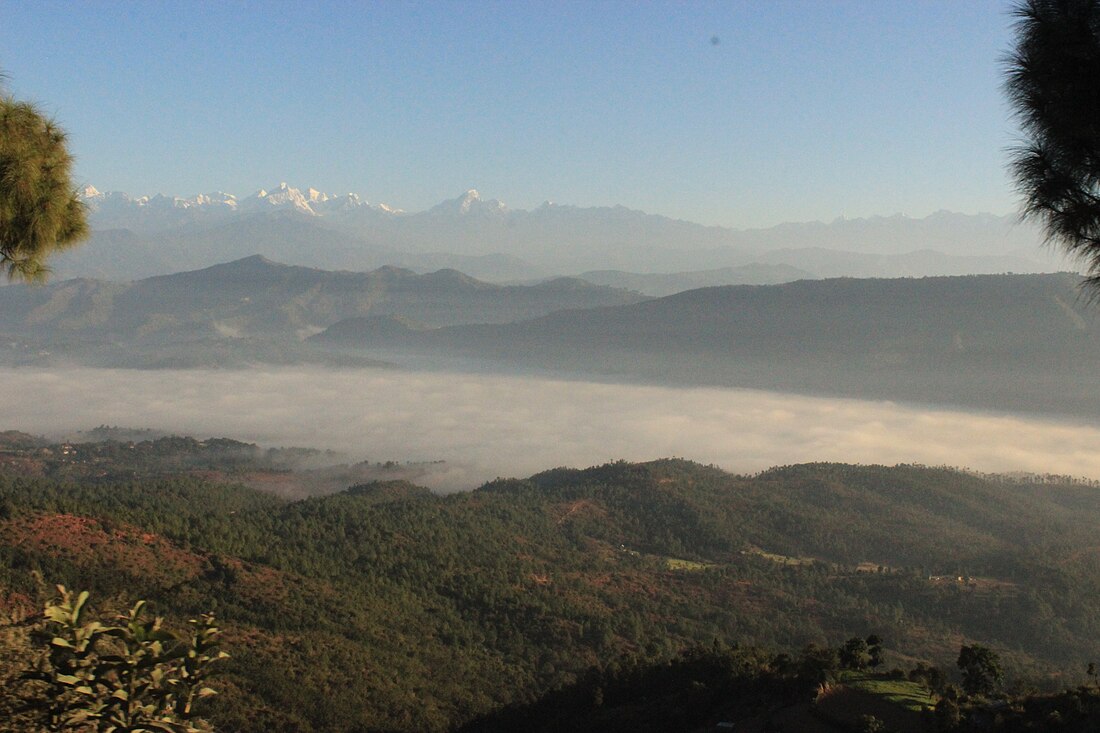Top Qs
Timeline
Chat
Perspective
Baglung District
District in Gandaki Province, Nepal From Wikipedia, the free encyclopedia
Remove ads
Baglung District (Nepali: बागलुङ जिल्ला pronounced [baɡluŋ] ⓘ), a part of Gandaki Province, is one of the seventy-seven districts of Nepal. The district, with Baglung as its district headquarters, covers an area of 1,784 km2 (689 sq mi) and has a population (2011) of 268,613.[1]
Remove ads
Introduction
Summarize
Perspective
Baglung is surrounded by Parbat, Myagdi, Rukum, Rolpa, Pyuthan and Gulmi districts. It has 59 Village Development Committees and one Municipality. Baglung has the moniker "District of suspension bridges" as there are numerous suspension bridges. It is a hilly district, and most of the population settled on the sides of the rivers. Fertile plains situated on either side of the rivers are used for farming. The headquarters of Baglung District is Baglung Municipality which is located on a plateau overlooking the holy Kali Gandaki. Like Nepal, Baglung is also diverse in religion, culture, ethnicity, altitude, temperature etc. Hinduism and Buddhism are the major religions.
Baglung is rich in herbal medicinal plants. Rice, Corn, Millet, Wheat and Potato are the major crops of Baglung. Small scale mining mostly for Iron and Copper was a major activity in Baglung in the past. However, due to the economics of operating small mines most have closed since. Slate mining remains the most widespread form of mining in present times.
Baglung Municipality, Hatiya- Galkot and Burtibang are the main trading centers of Baglung. Galkot, Kusma and Burtibang are connected by roads with the district headquarters Baglung Bazaar. Baglung is served by the Nepal Electricity Authority and various small local hydropower plants. Recently, the telephone has been accessible in almost all villages in Baglung. Baglung is considered to be one of the politically most conscious districts and it plays a significant role in Nepali politics.
Remove ads
Geography and climate
The highest temperature at the lowest elevation of Baglung rises up to about 37.5 degrees Celsius in summer and the lowest temperature at Dhorpatan falls up to about −15 degrees Celsius in winter. The elevation of Baglung varies from about 650 meters at Kharbang to about 4,300 meters in Dhorpatan.
Remove ads
Demographics
Summarize
Perspective
At the time of the 2021 Nepal census, Baglung District had a population of 249,211. 8.12% of the population is under 5 years of age. It has a literacy rate of 79.97% and a sex ratio of 1144 females per 1000 males. 513,504 (85.58%) lived in municipalities.[4]
Khas people make up 64% of the population, of which Chhetri and Kami are the largest groups. Khas Dalits are 28% of the population. Magars are the single largest ethnicity, making up 30% of the population.[5]
Languages of Baglung district (2021)[6]
- Nepali (94.2%)
- Magar (2.30%)
- Magar Kham (1.80%)
- Others (1.71%)
At the time of the 2021 census, 94.19% of the population spoke Nepali, 2.30% Magar and 1.80% Magar Kham as their first language.[6] In 2011, 94.2% of the population spoke Nepali as their first language.[7]
Administration
Summarize
Perspective
The district consists of 10 Municipalities, out of which four are urban municipalities and six are rural municipalities. These are as follows:[9]
- Baglung Municipality (the district's headquarter)
- Dhorpatan Municipality
- Galkot Municipality
- Jaimuni Municipality
- Bareng Rural Municipality
- Khathekhola Rural Municipality
- Taman Khola Rural Municipality
- Tara Khola Rural Municipality
- Nisikhola Rural Municipality
- Badigad Rural Municipality
Former Village Development Committees
Prior to the restructuring of the district, Baglung consisted of the following municipalities and Village development committees:
Remove ads
2015 Nepal earthquake
The district was moderately affected by an April 2015 Nepal earthquake. Many old buildings sustained damage and a few collapsed. Since then many of the buildings have been rebuilt by the owners.[citation needed]
See also
- Baglung Municipality
References
Wikiwand - on
Seamless Wikipedia browsing. On steroids.
Remove ads



